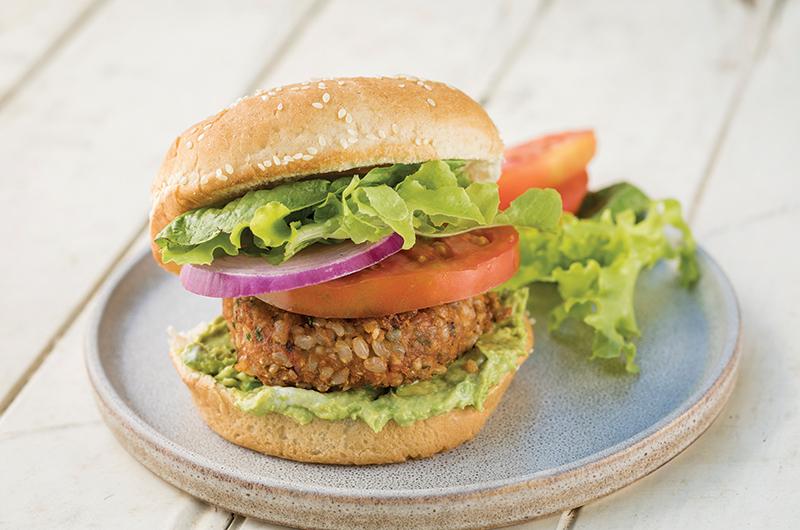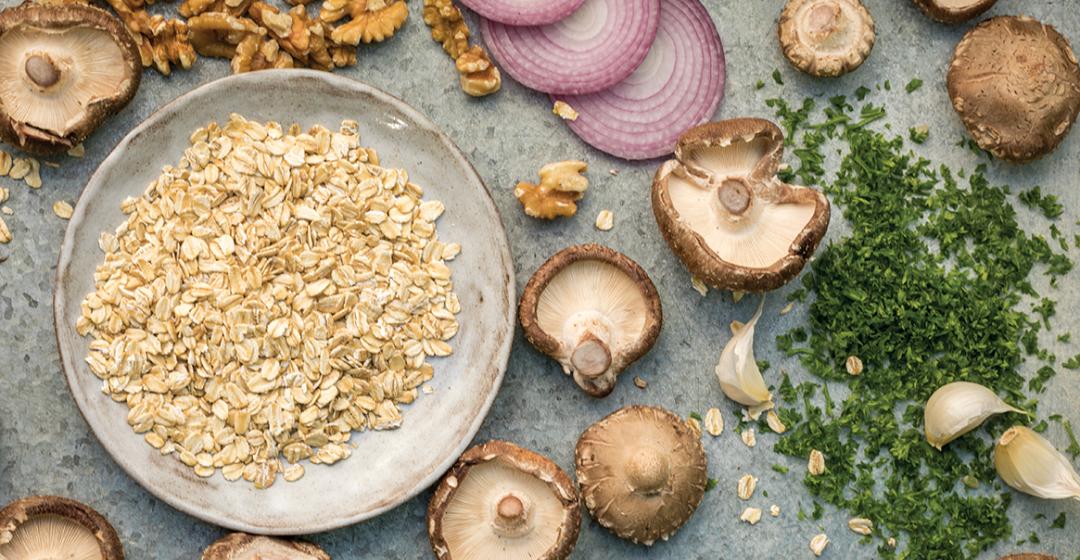There was a lot of talk over the past few years about the corporate race to create a veggie burger as close to meat as possible. A new addition on the market even replicates a turkey burger using plant-based ingredients. One of the bigger brands, the Impossible Burger, claims a non-meat alternative that looks pink on the inside and bleeds like a beef burger. It took tens of millions of dollars in research and development to get this effect.
The ingredients are water, soy protein concentrate, coconut oil, sunflower oil, natural flavors, and 2 percent or less of potato protein, methylcellulose, yeast extract, cultured dextrose, food starch modified, soy leghemoglobin, salt, mixed tocopherols, and soy protein isolate. They add some vitamins, including B-vitamins, zinc, and folate; each serving clocks in at nineteen grams of protein.
It’s the soy leghemoglobin (or heme) that is responsible for the look and taste of this burger, which is said to resemble meat. Heme, found abundantly in beef, produces complex flavor development during cooking. With the Impossible Burger, manufacturers take the heme DNA from the roots of soy plants and genetically insert and ferment that DNA in yeast to recreate the same, or close to the same, savory flavor and aroma of beef.
“You’re helping the planet in a big way,” the company boasts: eating a plant-based burger as opposed to real beef uses 96 percent less land, 87 percent less water, and 89 percent less in emissions, says the company literature.
And the taste? In taste tests with meat eaters, about half of the testers could not tell the difference between Impossible’s burger and a supermarket burger. Both my husband and son have tried the Impossible Whopper at Burger King and swear it tastes just like the regular Whopper. When I pan seared and served it on a bun with accompaniments to two vegetarians and one near vegetarian, I got a thumbs up from each of them.
I had a different reaction. I could barely get a bite down. From opening the package to forming the patties to biting into the “burger,” I was turned off at each step of the way. The slight odor when opening the package made me think of wet dog food from a can (sorry for this image). This wasn’t strong; I had to stick my nose close to detect it. The ingredient list did not help either. Then there was the texture, which is very soft, and the color pinkish. The meat squished in my hand, and I delicately formed the burgers, adding some salt and pepper, and brought them to the outdoor gathering to cook.
They browned up on the outside, and sure enough, small red droplets formed, giving the appearance and texture of meat. The instructions say to cook them to an internal temperature of 160 degrees to either medium rare or medium. I cooked them just enough to keep the center pink.
They may look like beef, but they do not really taste like beef, with that satisfying scent and flavor enhanced by grilling or browning in a skillet. Maybe a facsimile of beef or hint of beef. Either way, I did not want to eat more than a bite or two.

A vegetarian friend recommended another commercially available product, the Beyond Burger, so we gave those a try too. The plant-based patties boast twenty grams of protein per serving, mostly from “pea protein,” not soy, and a list of oils and supporting flavors. They, too, try to capture the juiciness and red-meat effect, here using pomegranate extract and beet juice.
“Tastes like meat and it feels like meat,” my son said, “but it doesn’t taste good.” My husband captured the flaws in these burgers that are trying to taste like meat, saying, “It’s close, like 90 percent, but it’s that last little whatever that isn’t authentic that colors the experience.”
As it turns out, I’m a purist. I like my meat-tasting burgers to be made from meat. And I like a plant-based burger that tastes like, well, natural ingredients. I’m lucky: since I’m not a vegetarian I can enjoy the best of both worlds. I’ll continue to eat ground-beef burgers every now and again. And if I want to save the planet – and I do – I can turn to veggie burgers made from real, pronounceable, not processed, potentially locally sourced, flavorful and healthful plant food.
I have plenty of recipes to call upon. From my first veggie burger enjoyed while attending chef training until now, nearly twenty-five years later, I have tried all different types of non-meat burger recipes, never passing by a recipe that looks promising. Even as I was working on this article, someone sent me a recipe for the namesake patty from Superiority Burger in NYC, made with quinoa, shredded carrots, and chickpeas. I made a note to try these soon, given the title and cult status.
For a plant-based burger to make my list of keeper recipes, it can’t just be a nutritional powerhouse; it also needs to taste good. Most recipes have some combination of chopped or shredded vegetables, such as carrots, celery, red pepper, fennel, red onions, even kale, along with chopped herbs, such as parsley or cilantro. Many feature brown rice or quinoa, and often beans. The beans and whole grains provide protein and bind the veggie burger without the need for an egg. Often the ingredients are complemented by bold flavors, such as soy sauce, mustard, spices, and garlic.
That first veggie burger we made in cooking school mixed four or five different grains and cooked them together, then added liquid smoke, along with other flavorings. With or without a bun, it was flavorful, a bit crispy from pan frying, and full of whole grains. It never occurred to me to create veggie burgers to taste like meat, though I knew that when someone added liquid smoke or smoked paprika, they were aiming to satisfy vegetarians as well as to lure meat eaters.
For those attempting to eat less meat for both their own health and the health of the planet, the veggie burger is a great way to add a vegetarian entrée. They’re easy to serve to a crowd, especially since you make them ahead. Almost any type of slaw or salad or roasted vegetable works alongside them. They are pretty economical too, using ingredients you might have in the fridge or pantry. You can even use leftover grains.
Of course, there are some downsides to homemade veggie burgers. For one thing, they take some effort: you might have to cook a grain if you don’t have one left over, and you definitely have to chop a few veggies and measure out some of the flavoring elements. Another drawback, for some, is the texture. Unlike a hamburger, which you can throw on a grill, veggie burgers are delicate to cook. They aren’t really meant for a grill. Sometimes they fall apart on a bun. But melt some cheese, add a tomato and smashed avocado or red onion, and watch them disappear.
Here I’ve included two of my favorite recipes from the keeper’s list. The first uses local shiitake mushrooms. The second recipe is closely based on one of my all-time favorite veggie burger recipes that originally appeared in The First Mess Cookbook (Avery, 2017), by Laura Wright. A typical healthy veggie burger, it has a balanced combination of grains, beans, and veggies, and flavor to match.
You’ll notice that in the burger war, between store-bought versions, restaurant offerings, and those you make at home, the name matters. Many try to lure you with their promises: the “Best Veggie Burgers on the Planet” to “Ultimate Veggie Burgers.” Perhaps I should change the name of my “Shiitake Mushroom Burgers” to the “Mightiest Mushroom Burgers.”
The following recipes were published along with this article:







